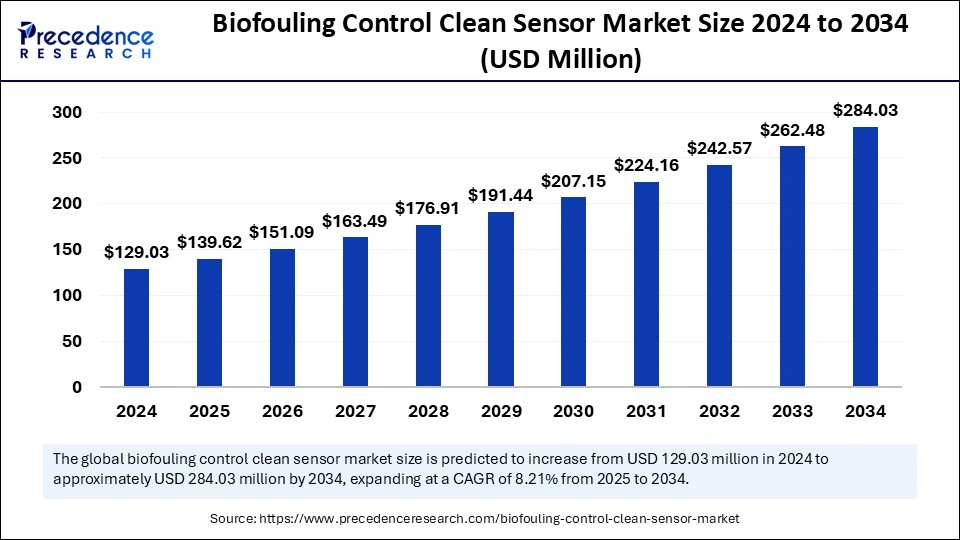Biofouling control clean sensor market size to hit USD 284.03 Mn by 2034, rising from USD 129.03 Mn in 2024, growing at a CAGR of 8.21%.

Biofouling Control Clean Sensor Market Key Takeaways
- Asia Pacific dominated the global market with the largest share in 2024.
- Europe is expected to expand at the highest CAGR during the forecast period.
- By type, the electrochemical fouling control system sensor segment held the major market share in 2024.
- By application, the marine engineering segment contributed the biggest market share in 2024.
- By application, the industrial production segment is expected to grow at the fastest CAGR during the projection period.
Biofouling Control Clean Sensor Market Overview
The biofouling control clean sensor market is experiencing robust growth due to the increasing demand for high-precision sensor systems in marine, industrial, and environmental applications. Biofouling, which occurs when organic matter accumulates on sensor surfaces, can lead to sensor degradation and impaired performance. To address this challenge, biofouling control technologies such as advanced anti-fouling coatings, UV sterilization, and electrochemical cleaning methods are being deployed to maintain sensor efficiency and ensure accurate data collection. Industries such as oil and gas, aquaculture, and water treatment are increasingly relying on biofouling control solutions to minimize maintenance costs and enhance the operational lifespan of sensor systems.
The incorporation of artificial intelligence and machine learning technologies in biofouling prevention systems is further driving market growth by enabling real-time data analysis and adaptive response mechanisms.
Biofouling Control Clean Sensor Market Drivers
The primary drivers of the biofouling control clean sensor market include the growing need for accurate and reliable sensor systems in critical applications and the rising adoption of sensor technologies in environmental monitoring and marine exploration. Biofouling can cause signal distortion and reduce the sensitivity of sensors, necessitating the implementation of effective biofouling control solutions. The increasing deployment of sensor systems in aquaculture and offshore energy projects is further boosting market demand.
Additionally, regulatory mandates aimed at minimizing the environmental impact of biofouling and promoting sustainable sensor maintenance practices are encouraging organizations to invest in biofouling prevention technologies. The growing focus on digital transformation and smart sensor networks is also driving the adoption of biofouling control solutions that ensure seamless data collection and analysis.
Biofouling Control Clean Sensor Market Opportunities
The biofouling control clean sensor market offers significant opportunities for innovation and expansion, particularly in emerging sectors such as offshore wind energy, smart water management, and underwater robotics. The development of nanotechnology-based anti-fouling coatings and bio-inspired materials is creating new possibilities for enhancing sensor performance and durability. The increasing integration of IoT devices and wireless sensor networks in industrial and environmental applications is driving demand for biofouling-resistant sensor systems.
Additionally, the rising adoption of predictive maintenance and condition-based monitoring technologies is enabling organizations to optimize sensor performance and extend operational lifespan. The emergence of advanced electrochemical cleaning methods and UV-based disinfection systems is further enhancing the effectiveness of biofouling control solutions.
Biofouling Control Clean Sensor Market Challenges
The biofouling control clean sensor market faces several challenges that may impact its growth trajectory. One of the key challenges is the high cost associated with the development and implementation of advanced biofouling prevention technologies. Small and medium-sized enterprises may face financial constraints in adopting these solutions, limiting market penetration.
Ensuring the long-term effectiveness of anti-fouling coatings and maintaining sensor performance in harsh environmental conditions is another challenge that requires continuous innovation and research. Additionally, the integration of biofouling control technologies with existing sensor systems can be complex and may require specialized expertise, further increasing operational costs.
Biofouling Control Clean Sensor Market Regional Insights
North America leads the biofouling control clean sensor market, driven by the presence of established sensor technology providers and a strong emphasis on marine research and environmental sustainability. The United States is a key contributor to market growth, with significant investments in underwater sensor systems and biofouling prevention technologies. Europe is another major market, with countries such as Germany, the United Kingdom, and Norway promoting the adoption of biofouling control solutions to support sustainable marine practices.
The Asia Pacific region is witnessing rapid growth, fueled by increasing investments in aquaculture, offshore energy, and water management projects. China, Japan, and South Korea are driving market expansion in the region through the adoption of advanced sensor technologies and biofouling prevention solutions. Latin America and the Middle East & Africa are gradually embracing biofouling control technologies, supported by growing awareness of the benefits of clean sensor systems in industrial and environmental applications.
Biofouling Control Clean Sensor Market Recent Developments
Recent advancements in the biofouling control clean sensor market include the development of highly effective anti-fouling coatings that utilize nanotechnology to prevent biofilm formation. The integration of artificial intelligence and machine learning in biofouling prevention systems is enabling predictive maintenance and real-time data analysis, enhancing sensor performance. Strategic collaborations between sensor manufacturers and research institutions are driving innovation in biofouling control technologies.
The adoption of electrochemical cleaning and UV-based sterilization methods is further contributing to the effectiveness and reliability of biofouling control solutions.
Biofouling Control Clean Sensor Market Companies
- EVAC Group
- Yokogawa Electric Corporation
- ABB Ltd.
- KROHNE Group
- Veolia Water Technologies
- ALVIM SRL
- Sea-Bird Scientific
- ANB Sensors
- Green Eyes
- AML Oceanographic
- RBR Ltd
- Hydrolab
- Aanderaa
Segments Covered in the Report
By Type
- Electrochemical Fouling Control System Sensor
- Stoichiometric Fouling Control System Sensor
By Application
- Marine Engineering
- Aquaculture
- Industrial Production
- Others
By Geography
- North America
- Europe
- Asia Pacific
- Middle East & Africa
Ready for more? Dive into the full experience on our website!
